One of the blockbuster hits of this year’s California State Fair, taking place July 15-31 at Cal Expo in Sacramento, is the deep-fried pork chop on a stick from the stand Eat at Joe’s. Golden-brown and dusted in a secret seasoning blend, it’s the epitome of the once-a-year decadence of the fair, which was canceled in 2020 and 2021 due to the pandemic. It also illustrates how much more expensive it has become to run a food business in 2022.
The only food booth to offer deep-fried pork chops is Eat at
Joe’s. Owner Joe Mestmaker is joined by Eat at Joe’s staff member
Kym McGeorge.
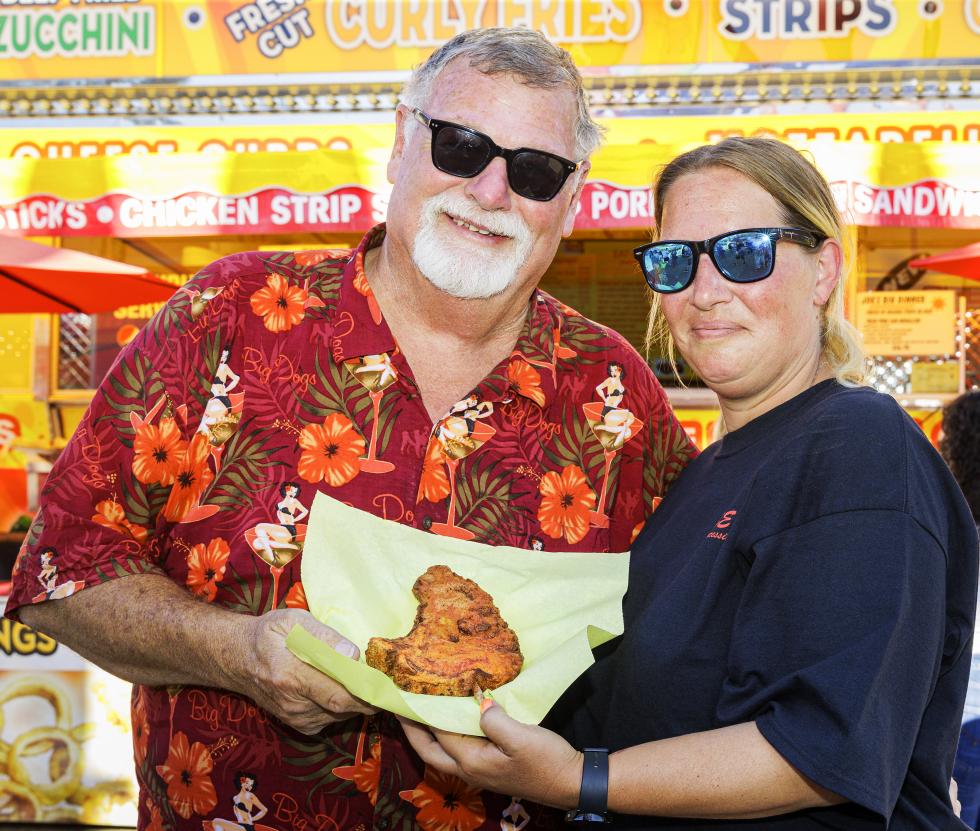
“Just oil alone, it costs us $700 just to fill the fryers,” says Joe Mestmaker, owner of Eat at Joe’s, who is based in Bakersfield and has been vending at fairs around the West Coast for nearly three decades. And that’s just the cooking kind of oil, which has reached record prices due to the war in Ukraine and other disruptions; the cost of fuel for firing the cookers and hauling gear and employees around the state has also skyrocketed. Pork, too, has risen in price, continuing a trend that began with plant closures and labor shortages in 2020.
Carlos Educido Sevilla adds grilled toppings to Juicy’s jalapenos
and cheese sausage sandwich.
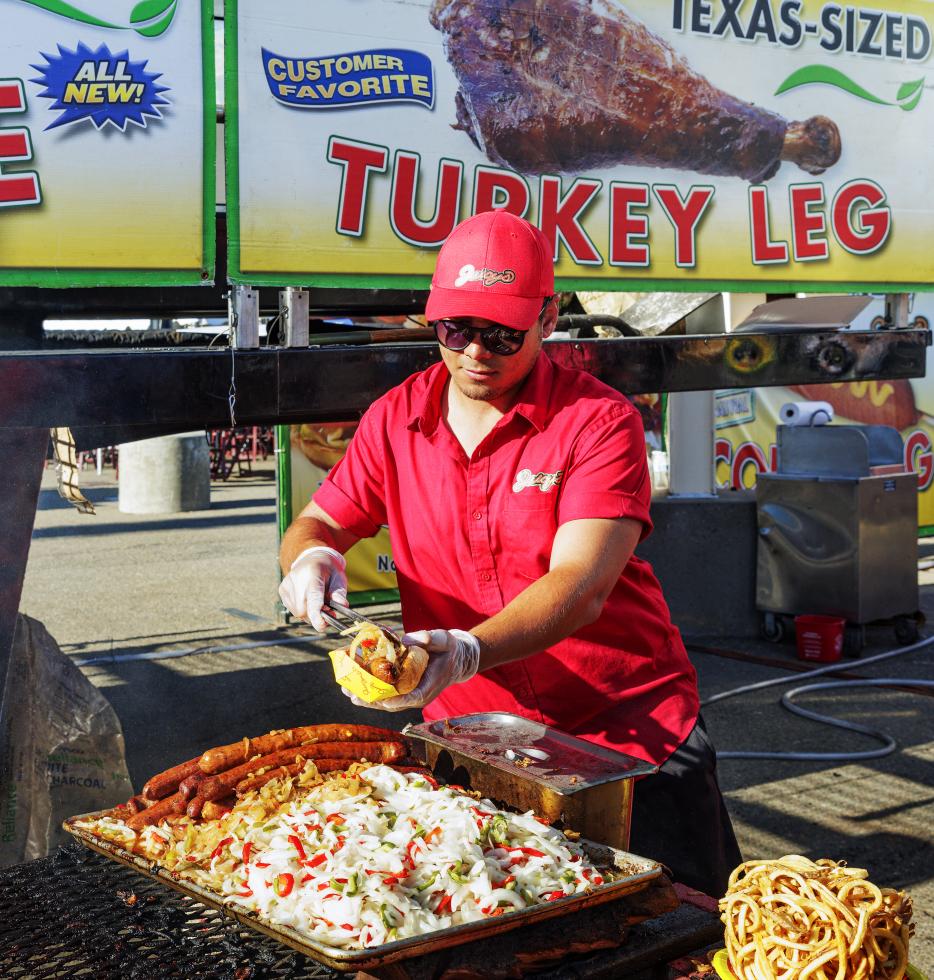
Fair vending has a tight profit margin in any case, with 27 percent of Mestmaker’s post-tax sales going to Cal Expo as commission (sometimes called a percentage-based rent). Vendors also have to put down a deposit, which can be $5,000 or more depending on the fair, and pay to park their vehicles. Mestmaker says he has increased his prices about 25 percent to keep up, though his costs have increased 50 percent or more. “I know it’s the middle or middle-lower class families that come out,” he says. “We try to keep our prices a little bit affordable for them.”
The Juicy’s booth cooks their BBQ chicken using a cinder-block
fire pit.
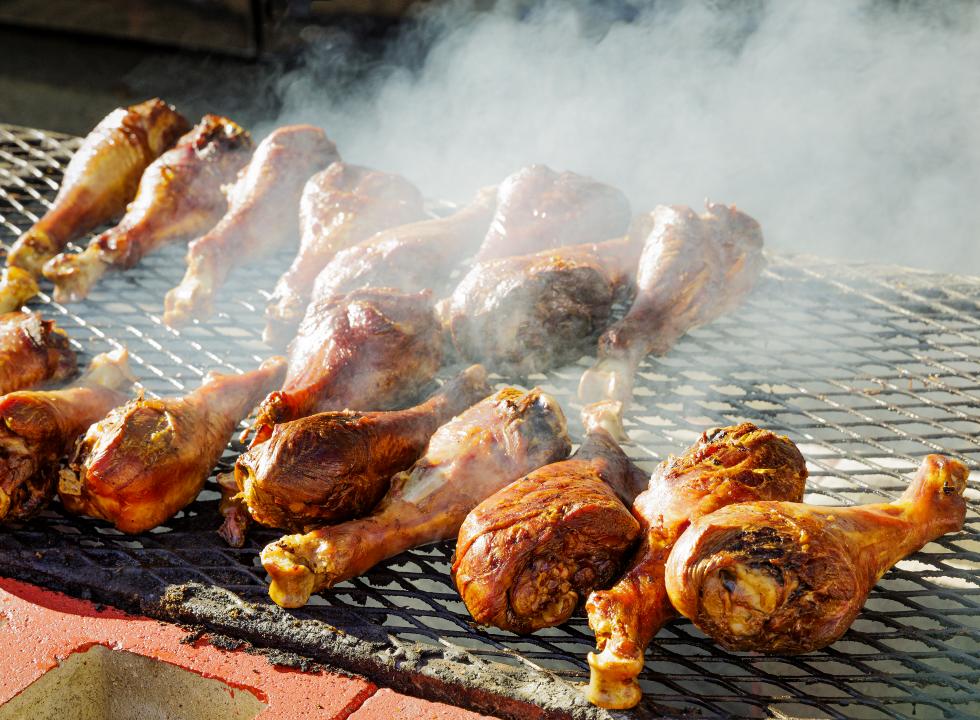
And families are coming out in force at the fair, despite triple-digit temperatures this week. There are the usual fairground attractions to attract them, like twirling rides, live music (including 1990s stars TLC and Smash Mouth) and animal exhibitions, but the focus is clearly on food. In addition to over 100 food vendors, the event features demonstrations by local chefs, competitions for California products like cheese and olive oil, an Iron Chef-style cooking challenge and other alimentary amusements.
Making his first visit to the California State Fair is 3-year-old
Peter Valania. Michael Valania gives his son a taste of a giant
turkey leg as Alice Valania watches.
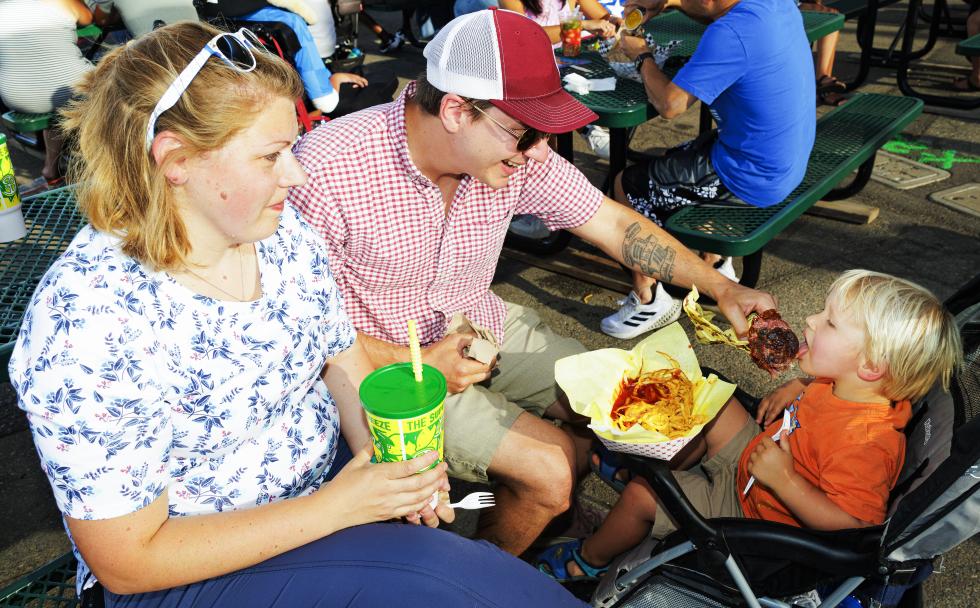
Rick Pickering, CEO of Cal Expo, says that food sales have increased this year compared to 2019 despite there being 23 fewer vendors. His team collects granular data on which menu items are most popular at different times of the day; they see that funnel cakes tend to rise in popularity after sunset, ice cream sales taper at 104 degrees or more, and shaved ice sales drop when temperatures cool to a relatively gelid 85. Wine slushies have been a standout seller throughout the event. “We typically sell more than a quarter of a million dollars in wine slushies in 17 days,” he says.
At the Chillin & Grillin BBQ booth, William Mejia keeps his eye
on grilled chicken kebabs. Chillin & Grillin BBQ, from Paso
Robles, returned for its eighth year as a California State Fair
vendor.
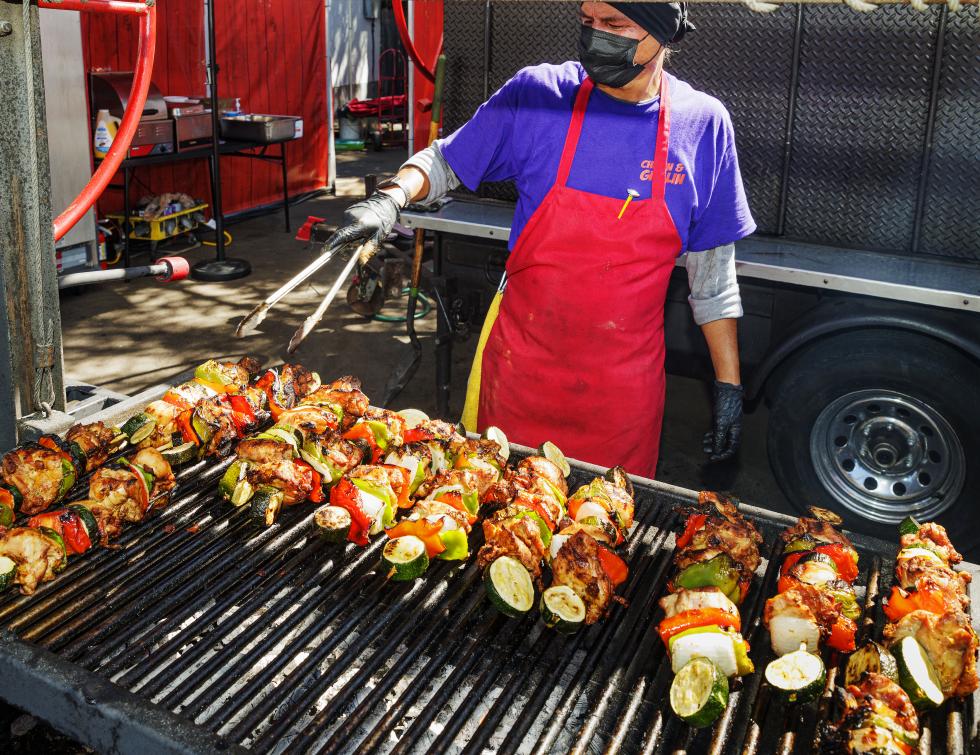
Families may be spending at the fair despite rising costs because it’s a relatively affordable summer indulgence, says Pickering, who wanders the picnic tables in a California State Fair t-shirt to strike up conversations with fairgoers. “What I’m hearing is, some people cannot afford to go away on vacation this year, so the state fair is their vacation,” he says.
Milo’s staff members show their excitement for the California
State Fair.

To help keep the fair affordable, Cal Expo kept admission and parking fees at 2019 rates. Visitors can also get free admission tickets in return for three non-perishable food items on SMUD Giving Mondays, which benefit local food banks.
Bacon wrapped dogs, western dogs, cheddar dogs, keto dogs,
Chicago dogs, kraut dogs, chili cheese dogs, classic hot dogs and
more are available at the Hot Doggin Gourmet Hot Dog booth.
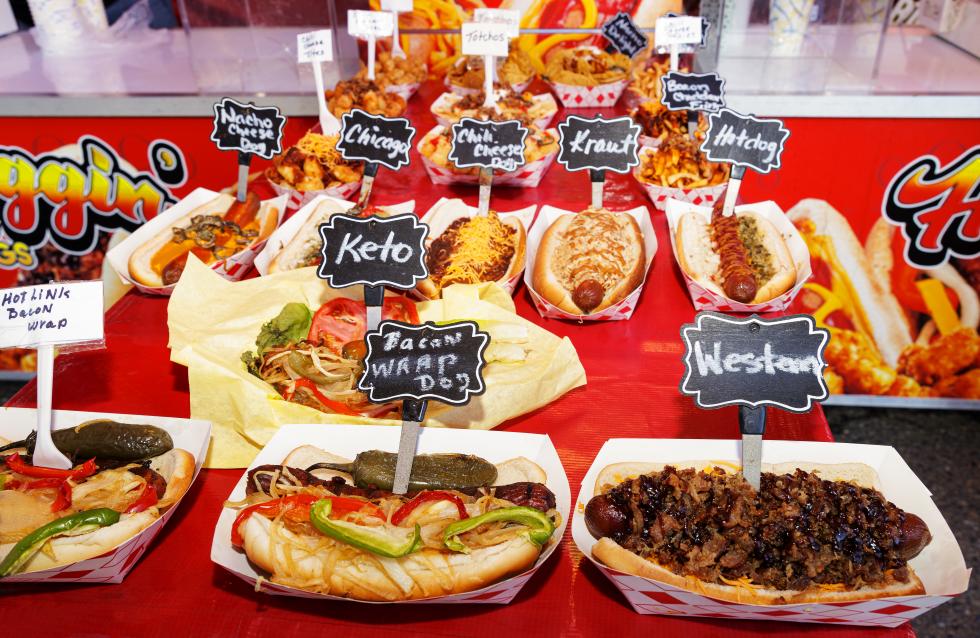
Another way to ease the sting of higher prices — and to taste more items in a day — is the $2 Taste of the Fair, first introduced in 2018. On Wednesdays and Thursdays between 11 a.m. and 4 p.m., vendors offer snack-sized versions of some of their most popular items for $2, like an al pastor taco from Pepe’s Fresh Mexican Food or a single rib from Chillin & Grillin BBQ.
Emign Turnbull, from Sacramento, enjoys a cookies-and-cream
loaded milkshake from the Fabe’s Churros and Gelato booth.
Fabe’s, from Southern California, is a regular vendor at the
California State Fair.
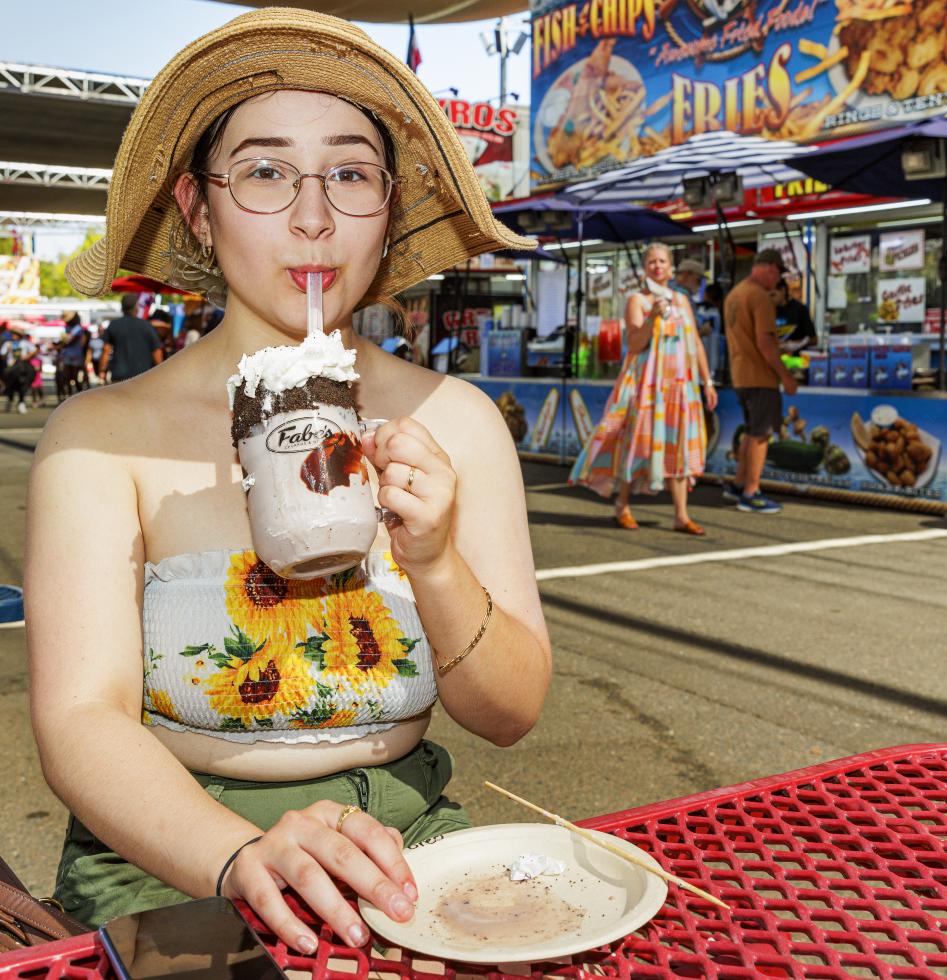
“The $2 option is great for fairgoers since fair food is usually pretty expensive,” says Nalini Chandra, co-owner of the Indian-inflected fried chicken restaurant Wing Mahal in Folsom, which is offering three boneless wings in the restaurant’s signature “fusion sauce” for $2 at the fair. It’s Wing Mahal’s first year at the fair; they were invited as part of a push to bring more diversity into the food offerings.
It’s difficult to make a profit at that price point, though, so vendors say they’re glad that the $2 days only come two days a week. Pickering says the deal can encourage customers to try a new vendor, where they might later buy a full-size option.
At the Pepe’s Agua Frescas and Fruit booth are members of the
Cloud family: son Jermaine (enjoying his giant turkey leg), Holly
(center left), LeLe (center right) and daughter Jaylah (right),
all visiting from St. Louis, Missouri.

Mestmaker, who is hoping to make enough of a profit to make up for two years with almost no fairs, says that few customers have complained about the increase in prices. “They’re actually been pretty decent, and they understand. Inflation is everywhere,” he says. “So the customers have been great this year. They’re grateful that we’re out here, for the most part.”
At the Sharky’s booth, UC Davis students Julianne Briones (left)
and Renae Briones are ready to try deep-fried artichoke hearts.

–
Stay up to date on business in the Capital Region: Subscribe to the Comstock’s newsletter today.
Recommended For You
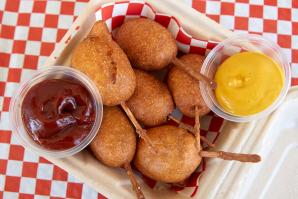
Photos: Fair Days Have Come to Woodland Restaurants
A group of 13 restaurants have joined together to participate in Downtown Woodland Fair Days, a special event to bring iconic foods to customers missing fairs canceled due to the pandemic.
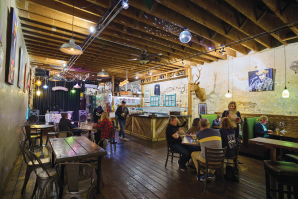
Tourism Out of Troubled Times
How lockdowns helped Californians discover local treasures of the past and present
As national and international tourism decreased during the
pandemic, regional visitation saw a boost. We profile three small
picturesque towns that got a big increase in visitors.



